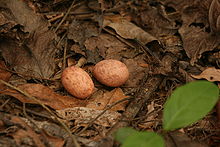- Pauraque
-
Pauraque 
Common Pauraque from North America
From Louis Agassiz Fuertes' Bird Lore (1926)Conservation status Scientific classification Kingdom: Animalia Phylum: Chordata Class: Aves Superorder: Neoaves (unranked) Cypselomorphae Order: Caprimulgiformes Family: Caprimulgidae Genus: Nyctidromus
Gould, 1838Species: N. albicollis Binomial name Nyctidromus albicollis
(Gmelin, 1789)The Pauraque (Nyctidromus albicollis) – also called the Common Pauraque to distinguish it from similar species – is a nightjar species, the only bird in the genus Nyctidromus. It breeds in the subtropical and tropical of the New World, and except for northernmost birds it is largely resident all year round.[1]
Description
This medium-sized nightjar is 8.7-11 in (22–28 cm) long and has two colour morphs, the plumage being variegated greyish-brown or rufous-brown. It is long-tailed and has broad rounded wings. The buff 'eyering' and 'facial stripe' contrast with the reddish sides of the face.[1]
The adult male Pauraque has a white band near the wing tips, and the outer tail feathers are mainly white. The female's wing band is narrower and the white in the outer tail is more restricted. There are seven subspecies of the Pauraque, differing in size and greyness.[1]
The male Pauraque's song is very variable, but includes a whistled weeeow wheeooo, ("who-r-you"), soft puk puk and a whip given in the courtship flight as he flutters around the female. Her call is a rapid succession of whip sounds.[1]
Distribution and ecology
The breeding range of the Common Pauraque extends from southern Texas to the lower Paraná River region. Most populations are all-year residents, although the U.S. breeders (N. a. merrilli) may winter in eastern Mexico.[1]
At the southern end of its range, subspecies N. a. derbyanus ranges from central and southern Brazil into the adjacent parts of Bolivia, and through Paraguay into Argentina and Uruguay. Even the southernmost birds seem to be nonmigratory, but at the likmit of its range the species is only patchily distributed. For example, it is not recorded to breed in Entre Ríos Province (Argentina) and it is scarce in Rio Grande do Sul (Brazil); about its presence in Uruguay likewise little is known, except that a population of some size is found along the Yaguarón River in the Cuchilla de Mangrullo region.[2]
It is found in open woodland/grassland habitats, but also scrubland and crop fields. This species has long legs (by nightjar standards) with bare tarsi, and is more terrestrial than most of its relatives. If disturbed, it will sometimes run rather than fly, and it frequently rests on roads and tracks. In general it prefers mixed habitat which offers densely vegetated hiding places – ideally forest – for the day, as well as open landscape – perhaps even rivers or wetlands – to hunt at night. The Pauraque is nocturnal, like other nightjars, and starts to fly at dusk. Like its relatives, it feeds on insects caught in flight, usually by flycatching from a low perch, but also by foraging over open ground.[3]
No nest is made; the two elongated and elliptical pinkish eggs are placed upon the bare ground or leaf litter. They are occasionally eaten by smallish mammals, such as the Common Marmoset (Callithrix jacchus).[4]
Not globally threatened, it is considered a Species of Least Concern by the IUCN.[5] Being an adaptable species that will tolerate human disturbance of habitat well, the Pauraque has actually benefitted from limited deforestation. Logging creates areas of low and secondary growth, in which the birds are able to hunt more efficiently. However, it will of course abandon heavily built-up or clear-cut locales, and in addition it is very vulnerable to predation by feral dogs and cats, disappearing from areas where these pests are abundant.[6]
Footnotes
References
- Accordi, Iury Almeida & Barcellos, André (2006): Composição da avifauna em oito áreas úmidas da Bacia Hidrográfica do Lago Guaíba, Rio Grande do Sul [Bird composition and conservation in eight wetlands of the hidrographic basin of Guaíba lake, State of Rio Grande do Sul, Brazil]. Revista Brasileira de Ornitologia 14(2): 101-115 [Portuguese with English abstract]. PDF fulltext
- Azpiroz, Adrián B. & Menéndez, José L. (2008): Three new species and novel distributional data for birds in Uruguay. Bull. B.O.C. 128(1): 38-56.
- BirdLife International (BLI) (2008). Nyctidromus albicollis. In: IUCN 2008. IUCN Red List of Threatened Species. Downloaded on 18 November 2008.
- Cleere, Nigel (1998): Nightjars: a guide to nightjars and related nightbirds. Pica Press, Nr. Robertsbridge (East Sussex). ISBN 1-873403-48-8
- de Lyra-Neves, Rachel M.; Oliveira, Maria A.B.; Telino-Júnior,Wallace R. & dos Santos, Ednilza M. (2007): Comportamentos interespecíficos entre Callithrix jacchus (Linnaeus) (Primates, Callitrichidae) e algumas aves de Mata Atlântica, Pernambuco, Brasil [Interspecific behaviour between Callithrix jacchus (Linnaeus) (Callitrichidae, Primates) and some birds of the Atlantic forest, Pernanbuco State, Brazil]. Revista Brasileira de Zoologia 24(3): 709–716 [Portuguese with English abstract]. doi:10.1590/S0101-81752007000300022 PDF fulltext.
- Ingels, J.; Oniki, Y. & Willis, E.O. (1999): Opportunistic adaptations to man-induced habitat changes by some South American Caprimulgidae. [English with Portuguese abstract] Revista Brasileira de Biologia 59(4): 563-566. doi:10.1590/S0034-71081999000400005 PDF fulltext
External links
- Pauraque videos on the Internet Bird Collection
- Stamps (for Suriname, Venezuela) with ~RangeMap
- "Common Pauraque" photo gallery VIREO (includes egg clutch)
- Photo-Medium Res(with White feathers and white band); Article zeledonia.org—AOCR Photo: Face and frontal--High Res
Categories:- IUCN Red List least concern species
- Caprimulginae
- Nightjars
- Birds of South America
- Birds of the Guianas
- Birds of the Amazon Basin
- Birds of Central America
- Birds of the Yucatán Peninsula region
- Birds of Mexico
- Birds of the United States
- Birds of the U.S. Rio Grande Valleys
- Monotypic bird genera
- Animals described in 1789
Wikimedia Foundation. 2010.


